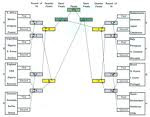The RMS velocity is exactly what is sounds like, it is the square root of the mean velocity of all the particles within a system. How one would determine the RMS depends very much on the system that one is dealing with.
Peak amplitude
In audio system measurements, telecommunications and other areas where the measurand is a signal that swings above and below a zero value but is not sinusoidal, peak amplitude is often used. This is the absolute value of the signal.
Peak-to-peak amplitude
Peak-to-peak amplitude is the measure of the change between peak (highest amplitude value) and trough (lowest amplitude value, which can be negative). Peak-to-peak amplitudes can be measured by meters with appropriate circuitry, or by viewing the waveform on an oscilloscope. Peak-to-peak is a straightforward measurement to make on an oscilloscope, the peaks of the waveform being easily identified and measured against the graticule. It remains a common way of specifying amplitude but sometimes other measures of amplitude are more appropriate.
FREQUENCY is the number of occurrences of a repeating event per unit time. It is also referred to as temporal frequency. The period is the duration of one cycle in a repeating event, so the period is the reciprocal of the frequency. Loosely speaking, 1 year is the period of the Earth's orbit around the Sun, and the Earth's rotation on its axis has a frequency of 1 rotation per day.
In physics, the WAVE LENGTH of a sinusoidal wave is the spatial period of the wave – the distance over which the wave's shape repeats. It is usually determined by considering the distance between consecutive corresponding points of the same phase, such as crests, troughs, or zero crossings, and is a characteristic of both traveling waves and standing waves, as well as other spatial wave patterns.
Sunday, June 13, 2010
AC sine wave

In alternating current (AC, also ac) the movement (or flow) of electric charge periodically reverses direction. In direct current (DC), the movement (or flow) of electric charge is only in one direction.
Used generically, AC refers to the form in which electricity is delivered to businesses and residences. The usual waveform of an AC power circuit is a sine wave, however in certain applications, different waveforms are used, such as triangular or square waves. Audio and radio signals carried on electrical wires are also examples of alternating current. In these applications, an important goal is often the recovery of information encoded (or modulated) onto the AC signal.
Sunday, May 30, 2010
FLUX LINES

flux
Flux is the presence of a force field in a specified physical medium, or the flow of energy through a surface. In electronics, the term applies to any electrostatic field and any magnetic field . Flux is depicted as "lines" in a plane that contains or intersects electric charge poles or magnetic poles.
*flux lines moves north to south.
*they never intersect each other.
*they can`t be broken.
*they always try and shorten.
Thursday, May 27, 2010
Sunday, May 16, 2010
HOW TO SOLVE RESISTER NETWORK

# Thevenin's Theorem is a way to reduce a network to an equivalent circuit composed of a single voltage source, series resistance, and series load.
# Steps to follow for Thevenin's Theorem:
# (1) Find the Thevenin source voltage by removing the load resistor from the original circuit and calculating voltage across the open connection points where the load resistor used to be.
# (2) Find the Thevenin resistance by removing all power sources in the original circuit (voltage sources shorted and current sources open) and calculating total resistance between the open connection points.
# (3) Draw the Thevenin equivalent circuit, with the Thevenin voltage source in series with the Thevenin resistance. The load resistor re-attaches between the two open points of the equivalent circuit.
# (4) Analyze voltage and current for the load resistor following the rules for series circuits.
Subscribe to:
Comments (Atom)




